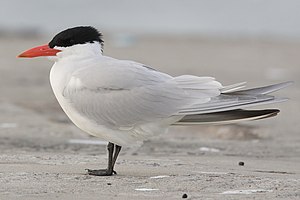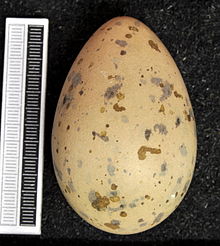Predatory tern
| Predatory tern | ||||||||||
|---|---|---|---|---|---|---|---|---|---|---|

Big tern ( Hydroprogne caspia , Syn .: Sterna caspia ) |
||||||||||
| Systematics | ||||||||||
|
||||||||||
| Scientific name of the genus | ||||||||||
| Hydroprogne | ||||||||||
| Kaup , 1829 | ||||||||||
| Scientific name of the species | ||||||||||
| Hydroprogne caspia | ||||||||||
| ( Pallas , 1770) |
The predatory tern ( Hydroprogne caspia , Syn .: Sterna caspia ) is a species of bird from the order of the plover-like . It is the largest type of family of terns .
Systematic position
A comparison of mitochondrial DNA showed that the terns are not a monophyletic group, i.e. do not have the same origin. Accordingly, the predatory tern is now classified in its own genus .
Appearance
Predatory terns are 48 to 55 cm in length and are slightly larger than common gulls . They fly with slower wing beats than other terns. As a special characteristic they have a strong red beak, dark brown feet and a slightly forked tail. The wings appear dark on the underside of the wing. In the splendid dress they have a deep black headstock, which is mixed with white feathers in the calm dress.
Young birds and females have identical plumage. The headstock and the back plumage are mixed here with dark brown feathers. Their beak is just a dull orange color.
habitat
Big terns nest in colonies on sandy coastlines and islands. Occasionally, small numbers of them can be seen on their migration in inland waters.
Predatory terns have a very large range. They are distributed from North America through Europe to Asia and are also part of the fauna of Australia . The northern European predatory terns primarily have breeding colonies on the northeastern Baltic coasts and overwinter mainly in West Africa and on the coasts of the Mediterranean.
Reproduction
Predatory terns only breed once a year. The nest is a shallow hollow in the sand. The clutch consists of two to three yellowish gray eggs with dark brown spots. The eggs are incubated by both parent birds for 22 to 24 days.
Food and subsistence
Predatory terns live on fish that they capture by shock dives. Often they can be observed before shaking . Occasionally the predatory terns will also eat young seabirds of other species.
Protection status
The predatory tern is threatened with extinction in Germany (Red List Category 1). It is a species in Appendix I of the EU Birds Directive (Directive 79/409 / EEC).
swell
- ↑ E. Bridge et al .: A phylogenetic framework for the terns (Sternini) inferred from mtDNA sequences: implications for taxonomy and plumage evolution. Elsevier 2004
- ^ Sangster, Collinson, Helbig, Knox, Parkin: Taxonomic recommendations for British birds: third report . In: Ibis . tape 147 , 2005, pp. 821-826 .
- ^ Svensson, Grant, Mullarney, Zetterström: Kosmos-Vogelführer, Kosmos 1999, p. 188
- ↑ Christoph Grüneberg, Hans-Günther Bauer, Heiko Haupt, Ommo Hüppop, Torsten Ryslavy, Peter Südbeck: Red List of Breeding Birds in Germany, 5th version . In: German Council for Bird Protection (Hrsg.): Reports on bird protection . tape 52 , November 30, 2015, ISSN 0944-5730 .
Web links
- Hydroprogne caspia in the endangered Red List species the IUCN 2008. Posted by: BirdLife International, 2008. Accessed January 31 of 2009.
- Videos, photos and sound recordings about Hydroprogne caspia in the Internet Bird Collection


